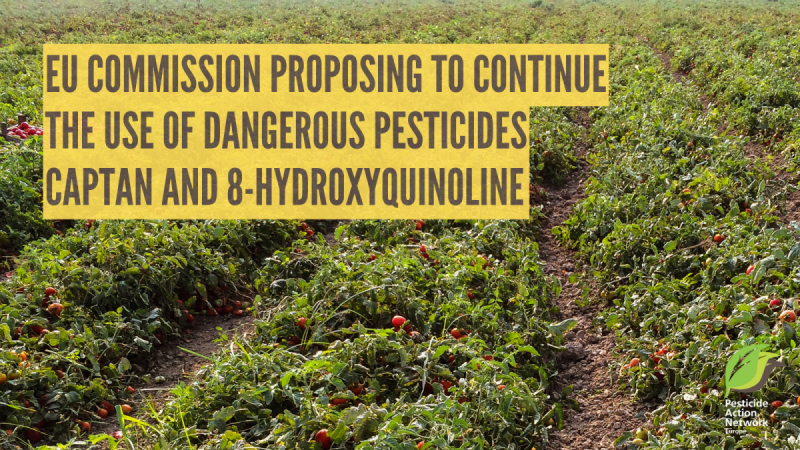This week the EU committee on pesticides SCoPAFF will discuss and vote on the renewal of two very toxic pesticides. Both proposals contradict EFSA’s scientific conclusions. Captan is one of the most used fungicides in Europe. It is suspected to be both carcinogenic and toxic to reproduction and pollutes the drinking water. Some studies link it to Parkinson’s disease. The use was supposed to be limited to closed greenhouses. But Austria has made a strong plea to keep using it in open fields. This proposal is now taken over by the EU Commission based on totally unrealistic and unscientific risk mitigation measures. The proposal to renew another highly toxic fungicide 8-hydroxyquinoline – a reprotoxic pesticide on our Toxic 12 list – is also highly problematic. PAN Europe and member organizations call on EU countries to reject these proposals. We also wrote to the committee with other concerns.
Behind the closed doors of the SCoPAFF committee, there have been strong discussions between representatives of EU Member States. A proposal to limit the use of captan in greenhouses - which was already considered an insufficient measure for such a toxic substance - was blocked twice by countries like Austria, Italy and Poland. Now the Commission has made a U-turn and proposes approval in open fields. This is based on an Austrian revised risk assessment with completely unrealistic mitigation measures. They introduce a totally new (non-existing) application method that sprays the trees but not the environment.
According to EFSA, captan poses a high risk to wild mammals, fish and aquatic invertebrates as well as non-target arthropods. These are “critical areas of concern”, which means EFSA has found no safe use of captan. When asked about the proposed Austrian mitigation measures, EFSA replied that it could not be realistically demonstrated that the risks would be lowered to an acceptable level. Some Member States raised the same concerns. Ironically, the fact that the measures were unrealistic was acknowledged by the Commission itself when responding to written questions from Members of the European Parliament a couple of weeks ago. (1) This puts the Commission in a very problematic situation given the recent EU General Court verdict that the Commission must ensure that such measures are actually (and not theoretically) demonstrated to re-approve a substance. (2)
Captan's risk extends beyond environmental impact to direct human health threats. A second concern with regard to captan is it poses a genuine risk to consumers via drinking water consumption, according to EFSA. This results from the recommendation by the European Chemical Agency (ECHA) to classify captan as toxic for reproduction (category 2). This classification adds to captan's existing status as a carcinogenic substance (category 2), raising alarms over groundwater contamination with this substance.
Moreover, the potential neurotoxicity of captan has not been properly researched. Worryingly, some studies link it to Parkinson’s disease. (3) Neurotoxicity is still not properly assessed in Europe. (4)
8-hydroxyquinoline can damage the unborn child
We also warn against the intention to renew 8-hydroxyquinoline for use in permanent greenhouses. This bypasses the ‘cut-off’ approach of the Pesticide Regulation for highly hazardous substances. In September 2019 8-hydroxyquinoline was classified as presumed to "damage the unborn child" (i.e. toxic for reproduction 1B). The substance also poses severe environmental risks, being highly toxic to aquatic life with long-lasting effects (Aquatic Acute 1 / Aquatic Chronic 1). PAN Europe has included the substance in the Toxic 12 list of chemicals that need to be banned immediately.
The Pesticide Regulation clearly establishes that reprotoxic substances cannot be approved in the EU unless “negligible exposure” to humans can be demonstrated in certain conditions of use. An exposure level that is almost impossible to achieve for such hazardous substances. EFSA's clarification in March 2024 stated that negligible exposure for 8-hydroxyquinoline cannot be ensured, especially in the case of automated drip irrigation in permanent greenhouses. The exposure risk to residents, bystanders, and particularly their children exceeds safe thresholds, contradicting the Commission's claims of “negligible exposure”. More generally, EFSA pointed to the clear weakness of its own risk assessment, which results in a need to cautiously interpret its conclusions for other exposure groups such as operators, farmers and farmworkers.
The letter to the EU Commission and Member States was signed by:
ECOCITY (Greece), Eco Hvar Non-Profit Association (Croatia), Ecologistas en Acción and Hogar sin Tóxicos (Spain), Générations Futures (France), (Spain), ISDE-Doctors for the Environment (Italy), Quercus (Portugal), Mouvement Ecologique (Luxembourg), Nature & Progrès and Bond Beter Leefmilieu (Belgium), PAN Germany (Germany), Via Pontica Foundation (Bulgaria), Friends of the Irish Environment (Ireland).
Notes:
(2) General Court of 21 February 2024 (Pesticide Action Network Europe (PAN Europe) v European Commission, T-536/22)
(3) Pesticide use and incident Parkinson’s disease in a cohort of farmers and their spouses
(4) EFSA scandal: management sabotages effective pesticide neurotoxicity assessment
Read more:
